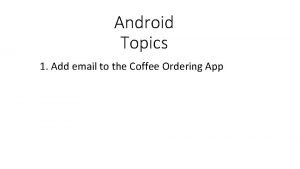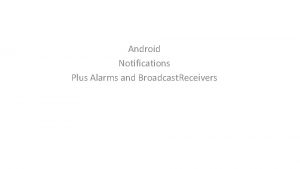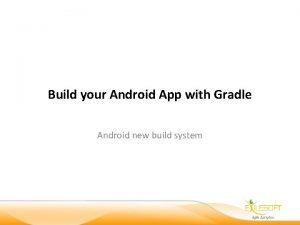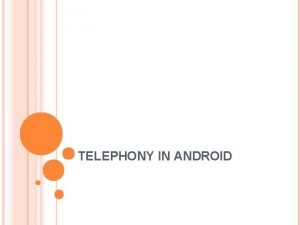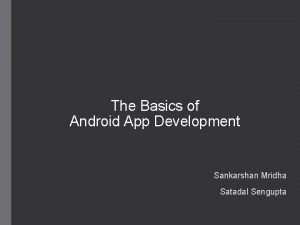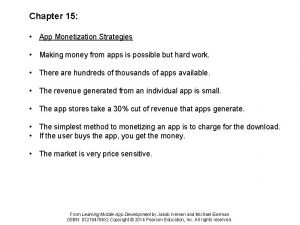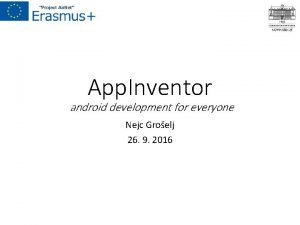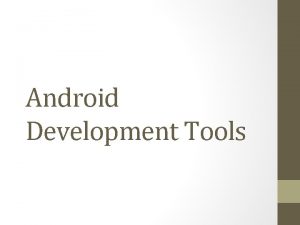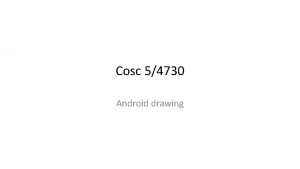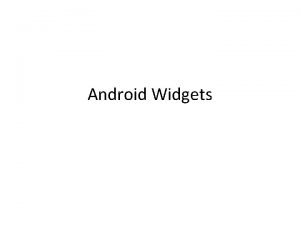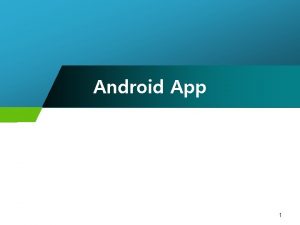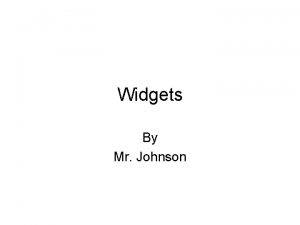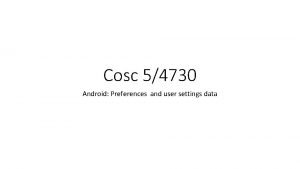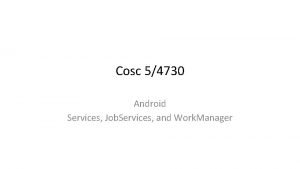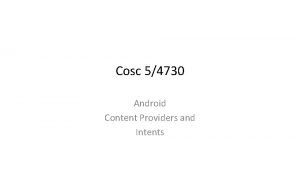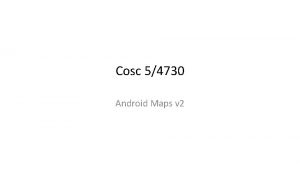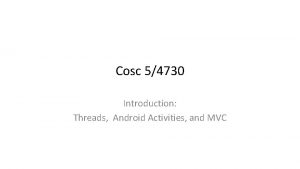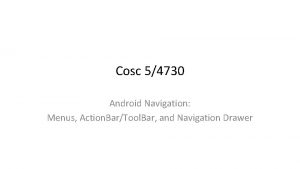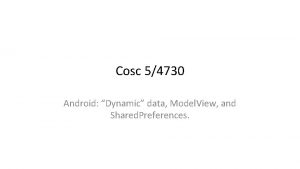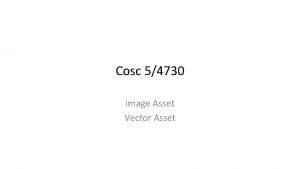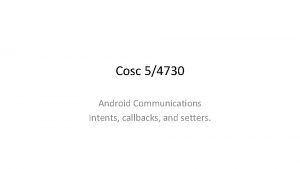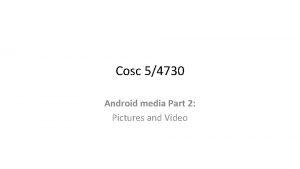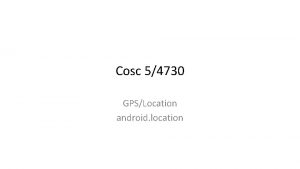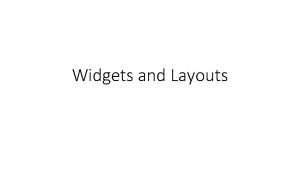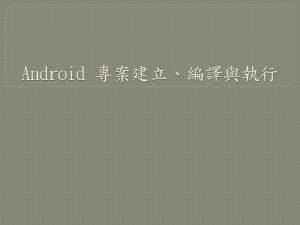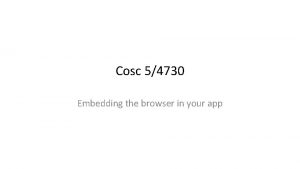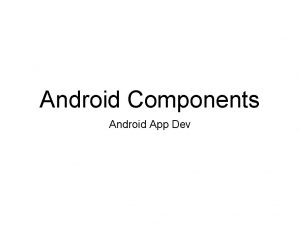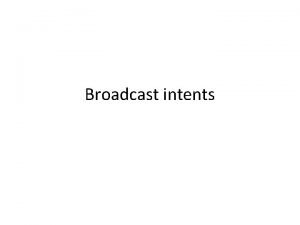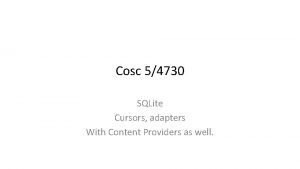cosc 54730 Android App Widgets App Widgets App





























- Slides: 29

cosc 5/4730 Android App Widgets

App Widgets • App Widgets are miniature application views that can be embedded in other applications (such as the Home screen and lock screen) and receive periodic updates. • These views are referred to as App Widgets in the user interface, and you can publish one with an App Widget provider. • An application component that is able to hold other App Widgets is called an App Widget host. • Example: Music App Widget.

Basics • You need the following: • App. Widget. Provider. Info object – Describes the metadata for an App Widget, such as the App Widget's layout, update frequency, and the App. Widget. Provider class. Defined in XML. • View layout – Defines the initial layout for the App Widget, defined in XML • App. Widget. Provider class implementation – Defines the basic methods that allow you to programmatically interface with the App Widget, based on broadcast events. – This is a Broadcast. Receiver. • An Activity, that can be used to configure the app. – Note it’s not required in 4. 1 or below.

Basics (2) • The App. Widget. Provider implements the on. Recieve() method of the Broadcast. Receiver and then calls: • You can also override the on. Receive() methods as well. But you need to call super. on. Receive(. . ) as the first thing. – – On. Enabled() when first instance is added to homescreen on. Disabled() when last instance removed from homescreen on. Delete() when the widget is removed from homescreen on. Update() called for every update of the widget. • A note, your widget can be added to the homescreen more then once.

Basics(3) • Broadcast. Receiver – registered to receive system messages and Intents. – In the case of app widgets, an example is a click event • Services (for advanced and not required) – This would update the widget without user interaction or outside the time update as well. – In API 26+ there are execution limitations, that make this more complex. See services.

Manifestfile. xml • In the application section, we will have the activity and we need to add the broadcastreceiver and intent-filter <receiver android: name="Example. App. Widget. Provider" > <intent-filter> <action android: name="android. appwidget. action. APPWIDGET_UPDATE" /> </intent-filter> <meta-data android: name="android. appwidget. provider" android: resource="@xml/widget_info" /> </receiver> • widget_info is the xml file that describes the widget in xml. – Note widget_info is just a file name and your file can have different names. (or more then one if you have multiple widgets).

App. Widget. Provider. Info • My file is called widget_info. xml in res/xml directory • You may need to create the xml directory first. <appwidget-provider xmlns: android="http: //schemas. android. com/apk/res/android" android: initial. Layout="@layout/example" android: min. Height="40 dp" android: min. Width="40 dp" android: resize. Mode="horizontal|vertical" android: update. Period. Millis="1800000" android: widget. Category="keyguard|home_screen" > </appwidget-provider> This can be used on the lock screen and home screen

App. Widget. Provider. Info (2) • Attributes: min. Width and min. Height is minimum space an App widget uses by default. – 1 cell is 40 dp, 2 is 110 dp, 3 cells are 180 dp, 4 cells are 250 dp. It recommended you don’t use more then 4 x 4 as default, because of screen size. • both height and width • See http: //developer. android. com/guide/practices/ui_guidelines/widget_design. html#anatomy_determining_size to determine size.

App. Widget. Provider. Info (3) • update. Period. Millis – How often an update to this widget is made. – A note, it can wake up every couple of minutes, but this will really drain the battery. This wakeup will happen even when the phone is asleep. – Google recommends no more lower then 30 minutes and prefers an hour. – Setting to 0, means it will not update without user intervention.

App. Widget. Provider. Info (4) • initial. Layout points to layout resource the widget uses. • Configure points to the activity the app uses to configure it self on launch (optional in some APIs, required in others) – Example: edu. cs 4730. widgetdemo. conf. Activity • The rest of for v 3. 0+ and above • min. Resize. Width and min. Resize. Height are how small it can be resized to • android: resize. Mode="horizontal|vertical" allows the widget to be resized in both directions. • android: widget. Category="keyguard|home_screen" allows the widget to on the homescreen and the lockscreen. • There a couple more as well for previews and other stuff.

View layout. • There will be in two pieces. – widget layout and the background layout • The layout in the app is a Remote. Views and has limited support for widgets and layouts – Frame. Layout, Linear. Layout, and Relative. Layout – Analog. Clock, Button, Chronometer, Image. Button, Image. View, Progress. Bar, and Text. View – v 3. 0+ added: Grid. Layout, View. Flipper, List. View, Grid. View, Stack. View, and Adapter. View. Flipper • The adapter is for a collection view widget.

Example layout <Linear. Layout xmlns: android="http: //schemas. android. com/apk/res/android" android: id="@+id/layout" android: layout_width="match_parent" This is the background xml, that we’ll create android: layout_height="match_parent" android: layout_margin="8 dip" next. android: background="@drawable/myshape" > <Text. View android: id="@+id/update" style="@android: style/Text. Appearance. Medium" android: layout_width="match_parent" android: layout_height="match_parent" android: layout_gravity="center" android: gravity="center_horizontal|center_vertical" android: layout_margin="4 dip" android: text="Text" > </Text. View> </Linear. Layout> Other then the background, then standard layout file

Myshape. xml <? xml version="1. 0" encoding="UTF-8"? > <shape xmlns: android="http: //schemas. android. com/apk/res/android" android: shape="rectangle"> <size android: width="35 dp" android: height="35 dp"/> <stroke android: width="2 dp" android: color="#FFFF" /> In /res/drawable/myshape. xml <gradient android: angle="225" android: end. Color="#DD 2 ECCFA" android: start. Color="#DD 000000" /> <corners android: bottom. Left. Radius="7 dp" android: bottom. Right. Radius="7 dp" android: top. Left. Radius="7 dp" android: top. Right. Radius="7 dp" /> </shape> See http: //developer. android. com/guide/topics/resources/drawable-resource. html#Shape For more information on shapes.

App Tutorial • This is a very simple widget. • It’s a button that displays a random number • It will update every thirty minutes • 1800000 milliseconds • Also registers a On. Click. Listener so random number updates when the user clicks on it.

App. Widget. Provider • Because this app is simple enough we will only use the on. Update method • Remember our widget can be placed on the homescreen multiple times, so have to deal with all of them – As note, the code has comments on how to configure it to update all widgets or just the widget that was clicked.

App. Widget. Provider (2) public class Example extends App. Widget. Provider { @Override public void on. Update(Context context, App. Widget. Manager app. Widget. Manager, int[] app. Widget. Ids) { // There maybe multiple widgets to update at the same time. int N = app. Widget. Ids. length; for (int i = 0; i < N; i++) { update. App. Widget(context, app. Widget. Manager, app. Widget. Ids[i]); } } The real work to update the widget is in this method

App. Widget. Provider (3) update. App. Widget( …) { int number = … get a random number • Construct the Remote. Views object, which the access we have to views Remote. Views remote. Views = new Remote. Views(context. get. Package. Name(), R. layout. examplewidget); • Set the text remote. Views. set. Text. View. Text(R. id. update, String. value. Of(number)); The layout we are using for the widget And this textview

App. Widget. Provider (4) • Now we register the “click” listener via an intent Intent intent = new Intent(context, Example. Provider. class); intent. set. Action(App. Widget. Manager. ACTION_APPWIDGET_UPDATE); • We need the widget ID in the intent int[] ids = {app. Widget. Id}; intent. put. Extra(App. Widget. Manager. EXTRA_APPWIDGET_IDS, ids); • And it needs a pendingintent. Pending. Intent pending. Intent = Pending. Intent. get. Broadcast(context, app. Widget. Id, intent, Pending. Intent. FLAG_UPDATE_CURRENT); • And set it to the view we want to “click” listener for (the Text. View) remote. Views. set. On. Click. Pending. Intent(R. id. update, pending. Intent); • Lastly instruct the widget manager to update the widget app. Widget. Manager. update. App. Widget(app. Widget. Id, remote. Views); }

Lastly • The “… get a random number” is using the shared preferences to load the max number for the random next int method. • As note, If you say new ->provider and include a config. Activity, it will provide you a lot of the template code, including the shared preferences as well.

Config activity • The activity that is launched at the time the widget is put on the homescreen. – It’s intended to configure the widget. – This is a normal activity with one exception • It must use set. Result(RESULT_OK, intent) and finish() or the widget will not be installed on the homescreen. – In the App. Widget. Provider. Info the following line is needed: – android: configure="edu. cs 4730. widgetdemo. example. Conf. Activity" – Again, if you have studio do this for you, it will setup everything including the accept button.

Examples • widget. Demo and widget. Demo 2 – Both example does the same thing. • widget. Demo was created via studio, so it fits the templates – I used this code as the example in the lecture. • widget. Demo 2 is older and doesn’t use the studio template. – Both use a shared preference widget max random number and each widget on the homescreen is configured separately (ie each has it own preference) – widget. Demo 2 maybe easier to follow how the preferences are done.

Example 3 • widget. Demo 3 – Add a second textview that allows the user to launch the configure activity and change the max value. – It creates a second intent and pendingintent and sets the onclickpendingintent to the second textview. • This intent is not a broadcast, instead it’s an activity intent.

“Buttons” and more actions • Since we don’t just want to update the widget, instead, we want to trigger other events. • You need to override on. Receive(…) – So you can catch the other events • Then setup an intent with an event for each “button” in the updateapp. Widget – Still uses set. On. Click. Pending. Intent(…) • Note, as with the last example, it doesn’t have to be a button.

Example code • Setup the events names, for the On. Receive(…) private static final String Button. Click 1 = "Button. Click. Tag 1"; private static final String Button. Click 2 = "Button. Click. Tag 2"; private static final String Text. Click = "Text. Click. Tag 1"; • in update. App. Widget(…) • setup actions for the two buttons and textview as too. remote. Views. set. On. Click. Pending. Intent(R. id. button, get. Pending. Self. Intent(context, Button. Click 1, app. Widget. Id)); remote. Views. set. On. Click. Pending. Intent(R. id. button 2, get. Pending. Self. Intent(context, Button. Click 2, app. Widget. Id)); remote. Views. set. On. Click. Pending. Intent(R. id. appwidget_text, get. Pending. Self. Intent(context, Text. Click, app. Widget. Id)); – get. Pending. Self. Intent is a method to create the pending. Intent quickly • Lastly setup On. Receive

Example code (2) • Now setup the On. Receive to deal the events. public void on. Receive(Context context, Intent intent) { super. on. Receive(context, intent); – The super. on. Receive is required, or the widget will not work. if (Button. Click 1. equals(intent. get. Action())) { – Do something for button 1 } else if (Button. Click 2. equals(intent. get. Action())) { – Do something for button 2 } else if (Text. Click. equals(intent. get. Action())) { } – Do something for the click on the textview } • The example code will toast for each one of them.

Demo code • widget. Demo. Buttons – Uses most of the code show before. – This is built from the basic template that studio provides and adds two buttons and a textview – All three actions are toasts that you “clicked it” • The textview shows it’s name that get from the preferences.

Advanced widgets • Many widgets show information about email, events, calendars etc. – They connect to a content provider • and use loaders – They connect to the internet to provide information – They have an associated services that will update the widget • or send notifications if the widget is not in use • Lastly, this may also appear on the lockscreen as well. Many “music players” like Pandora and Google's play music do this.

References • See the github for source code and more examples. • http: //developer. android. com/guide/topics/appwidgets/index. html • http: //developer. android. com/guide/practices/ui_guidelines/ widget_design. html • Useful but get out of date as well – http: //www. vogella. com/articles/Android. Widgets/article. html – http: //code 4 reference. com/2012/07/android-widget-tutorial/

Q&A
 Supply and demand graph
Supply and demand graph Luca widgets
Luca widgets Introduction of demand
Introduction of demand Vtk interactor style
Vtk interactor style The price of blue widgets rises to $6
The price of blue widgets rises to $6 Socicalnet widgets
Socicalnet widgets Abstract widgets
Abstract widgets Coffee ordering app in android studio
Coffee ordering app in android studio Conference bridge jive
Conference bridge jive Explain android application framework with their components
Explain android application framework with their components Android alarm app example
Android alarm app example App inventor vs android studio
App inventor vs android studio Gradle android app development
Gradle android app development Pedometer accelerometer algorithm android app
Pedometer accelerometer algorithm android app Canvas bgszc
Canvas bgszc Android telephony app
Android telephony app Android app
Android app App inventor vs android studio
App inventor vs android studio Bart dashboard
Bart dashboard Mit app inventor android emulator
Mit app inventor android emulator Android app monetization strategies
Android app monetization strategies App inventor vs android studio
App inventor vs android studio Lifecycle services android
Lifecycle services android Mal app android
Mal app android Cosc 3340
Cosc 3340 Cosc 1306
Cosc 1306 Cosc 4p41
Cosc 4p41 Cosc 101
Cosc 101 Cosc 2p12
Cosc 2p12 Cosc 121
Cosc 121







